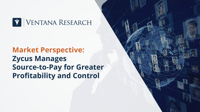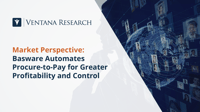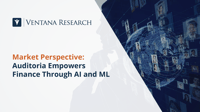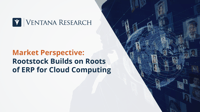As an organization transitions from being smaller and more informally managed to a larger business, it typically needs formal processes and controls. These ensure accurate financial reporting and protect the organization’s assets. These controls include, for example, systematic reviews and approvals, a second signature for the disbursement of material amounts, supervision when creating and removing customer accounts and three-way matching of invoices.
Read More
Topics:
Office of Finance,
ERP and Continuous Accounting,
digital finance,
Consolidate/Close/Report
The use of technology to manage source-to-pay as an end-to-end process beginning with vendor selection has grown significantly over the past five years. (Procure-to-pay is a related process that begins after vendor selection and P2P is a commonly used abbreviation covering both.) Organizations are looking to increase efficiency while promoting greater effectiveness by strategically taking early payment discounts, having more immediate and deeper insight into spend to achieve greater control and...
Read More
Topics:
Office of Finance,
ERP and Continuous Accounting,
Supplier Relationship Management,
Procure-to-Pay,
Purchase-to-Pay,
Purchasing / Sourcing / Payments
The use of technology to manage procure-to-pay as an end-to-end process has grown significantly over the past five years as organizations look to increase efficiency while promoting greater effectiveness. Beyond efficiency gains, benefits include strategically maximizing early payment discounts, having more immediate and deeper insight into spend to achieve greater control and optimizing supplier relationships. The related and often interchangeable term, source-to-pay, views the process...
Read More
Topics:
Office of Finance,
ERP and Continuous Accounting
The topic of artificial intelligence using machine learning (AI/ML) used to conjure up images of PhDs in white lab coats using massive computers to solve arcane problems, but today’s technology is packaged to be used effectively by those not trained in data science to address daily chores more efficiently. AI will be valuable to finance departments in five general areas: forecasting and planning, analytics, task supervision, recommendations and automated commentary. Although the payoff from...
Read More
Topics:
Office of Finance,
Analytics,
Business Planning,
ERP and Continuous Accounting,
AI & Machine Learning,
digital finance
Many small to midsize manufacturing and product-centric organizations have struggled with the limitations imposed by on-premises platforms designed for an unrelated industry or subvertical. Others try to cobble together processes and data from multiple systems and spreadsheets. While these organizations have many of the same requirements as larger enterprises, resources are not comparable, especially for technology support. Purpose-built software can meet specific industry requirements while...
Read More
Topics:
Office of Finance,
ERP and Continuous Accounting
Large corporations were the first to benefit from computers, but the cloud and availability of affordable, easy-to-use software has levelled the playing field for small and midsize organizations (SMBs). Software can significantly enhance organizational effectiveness by streamlining interactions with customers and employees, supporting collaboration within departments and across the enterprise, and promote efficiency by reducing the administrative burdens of record keeping and increasing...
Read More
Topics:
Office of Finance,
ERP and Continuous Accounting
The annual Ventana Research Digital Innovation Awards showcase advances in the productivity and potential of business applications as well as technology that contributes significantly to the improved processes and performance of an organization. Our goal is to recognize technology and vendors that have introduced noteworthy digital innovations to advance business and IT that optimizes organizational resilience and workforce readiness.
Read More
Topics:
Office of Finance,
Financial Performance Management,
ERP and Continuous Accounting,
Digital Innovation Awards,
profitability management
Indirect taxes — known variously as sales-and-use, value-added or goods-and-services tax — can get complicated, particularly in countries that have overly complex tax regimes such as Brazil, India and the United States. For example, in the U.S., state and local governments have their own statutes defining which goods are taxed and at what rates, and taxable items and rates change all the time. More recently, compliance has grown more complex with the Supreme Court’s Wayfair decision, which...
Read More
Topics:
Office of Finance,
Business Planning,
Financial Performance Management,
ERP and Continuous Accounting,
Revenue,
profitability management,
digital finance,
Lease & Tax Accounting
Financial consolidation is the process of combining financial data (notably assets, liabilities, income and expenses) from multiple subsidiaries’ general ledgers across an organization for the purpose of creating a parent company report. The current reality for financial consolidation and close processes is that many organizations still rely on manual spreadsheets, which can lead to longer closing periods, errors and confusion. According to SVP & Research Director in the Office of Finance...
Read More
Topics:
Office of Finance,
Business Planning,
Financial Performance Management,
ERP and Continuous Accounting,
Revenue,
profitability management,
digital finance,
Lease & Tax Accounting
The annual Ventana Research Digital Leadership Awards recognize organizations and individuals that utilize technology to advance business and IT. The Digital Leadership Awards showcase the professional leadership and their use of business applications or technology that contribute significantly to improved efficiency, productivity and the performance of their organization. This prestigious award recognizes leaders and pioneers who have contributed to their organization’s success and championed...
Read More
Topics:
Office of Finance,
Business Planning,
Financial Performance Management,
ERP and Continuous Accounting,
profitability management,
digital finance,
Lease & Tax Accounting
Over the past decade, close-management software has evolved to enable even midsize organizations to streamline department processes, operate in a virtual mode, accelerate the accounting close and reduce staff stress. It’s one step toward continuous accounting, which is defined by Office of Finance Research Director Robert Kugel as an approach to managing transactions recording and accounting that takes advantage of current technology to streamline and restructure the accounting function. In...
Read More
Topics:
Office of Finance,
Business Planning,
Financial Performance Management,
ERP and Continuous Accounting,
profitability management,
digital finance
Power ON is software designed for organizations to streamline their business planning, budgeting, forecasting, reviewing and reporting, in order to make these processes more effective and accurate. Organizations do a lot of planning: In addition to the budget, they plan headcount, sales, production and their supply chain, as well as other business functions, and traditionally execute this using spreadsheets as they are a familiar tool. However, spreadsheets make it difficult for individuals to...
Read More
Topics:
Office of Finance,
Business Planning,
Financial Performance Management,
ERP and Continuous Accounting,
revenue and lease accounting,
profitability management,
digital finance












